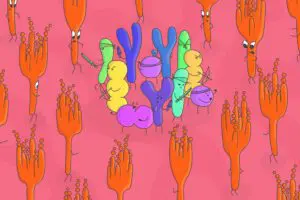ARTICLE SOURCE: https://gutmicrobiotaforhealth.com/en/antibiotic-induced-gut-dybiosis-may-influence-cognition-mice/
May 23, 2016
Mechanisms involved in gut microbiota-brain communication are largely unknown and a better understanding of these complex relationships might provide new targeted therapies. A recent study, led by Prof. Peter Holzer from the Research Unit of Translational Neurogastroenterology at Medical University of Graz in Austria, has found that intragastric treatment of mice with an antibiotic mixture impaired novel object recognition. This cognitive effect was associated with a disruption of the microbial communities in the colon, a depletion of bacteria-derived metabolites in the colon, and particular changes of neurochemical brain activity.
In the experiment, adult mice were treated in parallel with antibiotic (AB) mix or vehicle (VEH) by oral gavage for 11 days. Antibiotic treatment for 11 days consisted of a mix of five antibiotics: ampicillin, bacitracin, meropenem, neomycin, and vancomycin. The researchers allocated these mice to one of three groups: A, B, or C. Mice of group A were subjected to a behavioural test battery including open field test (OFT), elevated plus maze (EPM) test, tail suspension test (TST), and novel object recognition test (NORT) at different time points. After sacrifice at day 11, microbiome analysis, colonic content, plasma metabolic profile and cytokines, and brain quantitative real-time polymerase chain reaction (qPCR) for quantification of target gene expression were assessed. Mice of group B were habituated and trained in the Barnes maze (BM) test. Animals of group C were not subjected to any behavioural tests and were euthanized on day 10 to measure antibiotic concentrations in plasma and brain and investigate the effect of antibiotics alone on colon histology.
Of the antibiotics used, all were non-absorbable except ampicillin, which was absorbed slightly but did not enter the brain. Antibiotic treatment strongly disrupted and diminished the microbial community in the colon of antibiotic-treated mice. Also, microbial metabolite levels were markedly decreased in the colonic luminal contents of antibiotic-treated mice. Particularly, the colonic levels of the short-chain fatty acids acetate, butyrate and propionate as well as of trimethylamine, adenine and uracil were significantly diminished by antibiotic treatment. Circulating metabolite levels were also markedly altered by antibiotic treatment. Indeed, plasma concentrations of corticosterone were increased in antibiotic-treated mice, whereas the levels of other metabolites such as lysophosphatidylcholine 20:3 and p-cresyl sulphate were reduced. However, plasma concentrations of interleukin (IL)-1b, IL-6, IL-10, tumor necrosis factor (TNF)-a and interferon (IFN)-g were not altered by antibiotic treatment.
Novel object recognition (also termed non-spatial memory), evaluated with the memory index (MI) in the NORT was impaired in antibiotic-treated mice. In the NORT, antibiotic-treated mice had a significantly lower MI than vehicle-treated mice, which indicated that the mice spent less time exploring the novel object than the known object. However, spatial learning and memory assessed with the BM test remained intact in antibiotic-treated mice when compared to vehicle-treated mice.
Antibiotic treatment altered tight junction protein mRNA expression both in the amygdala and hippocampus, and the cerebral expression of neural signalling-related molecules that are involved in learning and memory. In particular, antibiotic-treated mice showed a significantly diminished brain-derived neurotrophic factor (BDNF) mRNA expression in the medial prefrontal cortex, hippocampus, and hypothalamus. The rise of plasma corticosterone in antibiotic-treated mice could contribute to BDNF downregulation. Since neuropeptide Y (NPY) contributes to cognitive processes, its expression and three of its receptors were also examined. It was found that NPY expression was markedly enhanced in the amygdala and hypothalamus of antibiotic-treated mice, which was matched by a downregulation of two of its receptors (NPY1R and NPY2R) in the hippocampus. Researchers highlighted that decreased NPY2R expression in the hippocampus could be a crucial factor involved in novel object recognition impairment due to antibiotic-induced gut dysbiosis.
In conclusion, antibiotic treatment of adult mice impaired object recognition, and both bacteria-derived circulating metabolites and cerebral neuropeptide Y played important roles in this process. Beyond the germ-free mouse model, the antibiotic-induced gut dysbiosis model appears to be an effective and less intrusive system for establishing causality in gut microbiota-brain relationships.






